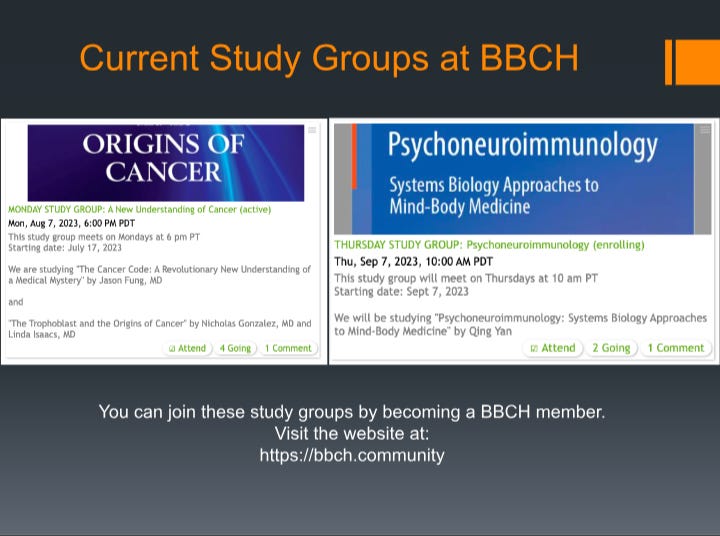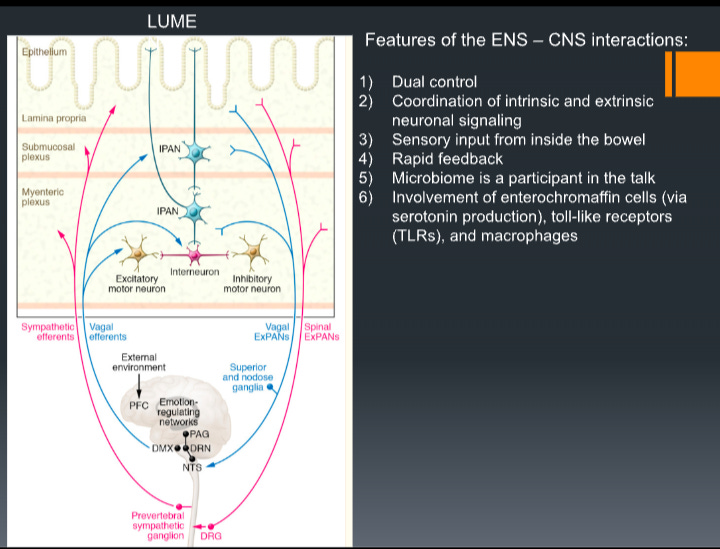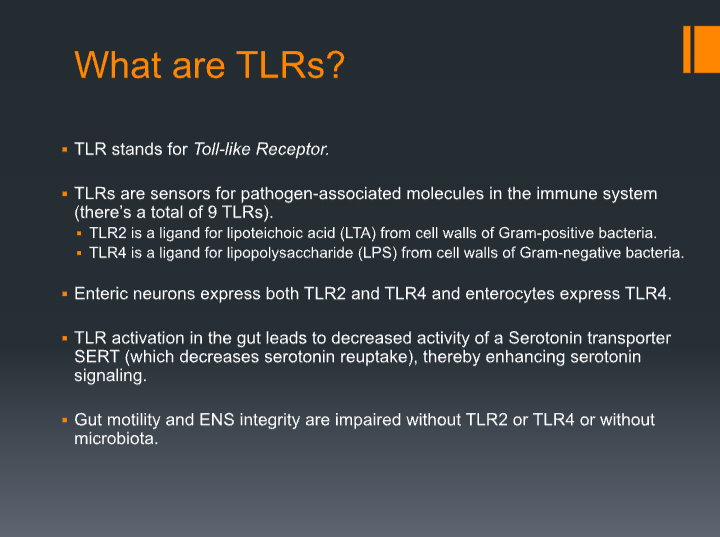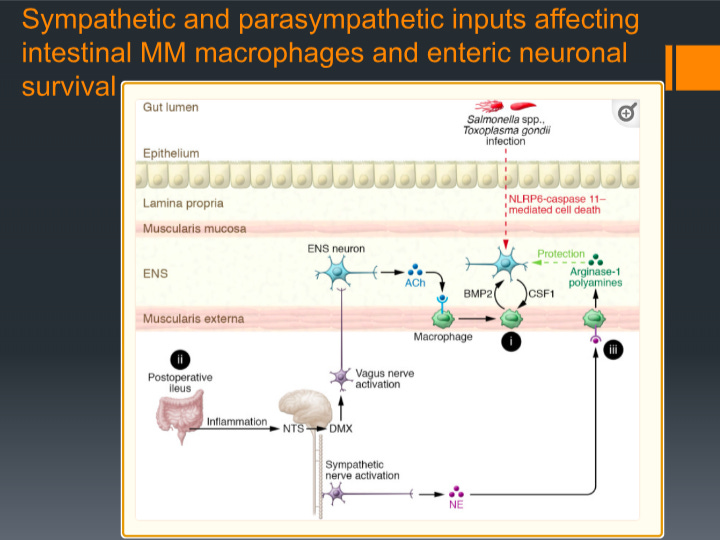ENS and our need for gut microbes to protect our intestinal lining and promote gut motility - peristalsis motion.
'Gut Feelings' a slide presentation to read, by Tetyana Obukhanych, PhD
Lack of gut microbes altogether is unhealthy for digestion. Peristalsis doesn't work as well and there are fewer support white blood cells for the Enteric nerve cells. Muscularis externa macrophages (MMs) are similar to the glial cells in the brain which support the nerve conducting cells, the gut nerves also have special helper macrophages. Certain strains of bacteria also are actively part of the system as protectors against Salmonella strains.
Total loss of the gut microbiome leads to a reduction in the support macrophages and since they help, there is a reduction in nerve control of peristalsis and gut function is decreased. This was learned from studying mice that were bred to have no gut microbes.
Diets that are too restrictive or lacking in fiber and resistant starch may end up worsening gut function then from reduced support macrophages and less peristalsis, less movement of the smooth muscles in the intestinal wall.
This is a great presentation on CoV, tryptophan and the gut ENS and microbiome, it was shared in the comments of the last post. Thanks!
A slide presentation to read by Tetyana Obukhanych, PhD, Immune Science Educator at BBCH: Gut Feelings - How Our Gut Microbiome and Intestinal Macrophages Impact the Enteric Nervous System (ENS) and Our Well-Being. https://docs.google.com/presentation/d/1a4FJRPjvTR050oKn9kF9F_o0KCZB8neg/mobilepresent (Obukhanych, 2023)
Gut Wall and Enteric Nervous System (ENS) Structure
Layering of brain cells is really important in the skull-brain too.
Aside - ultrasounds during early fetal development can literally move cells into wrong layers if the ultrasound is held over the same spot too long.
“Features of the ENS-CNS interactions”
Cross section of the Intestinal lining with the nerve pathways from the brain to the motor neurons of the Myenteric plexus and Submucosal plexus layers of the intestinal wall. The upper part of the graphic labeled “Lume” is the center of the intestinal tube and you can see wave like crevices of the outer layer of intestinal cells. Those form the villi and are topped with even smaller hair like microvilli - greatly expanding the total surface area of the intestinal wall which can interact with nutrients for digestion and absorption - or be damaged by a sudden blast of diarrhea or an overload of super acidic soda or ‘Energy drink’.
“What are TLRs?”
Toll-like Receptors act as sensors for specific chemicals associated with common pathogens that our body has to defend itself against. TLRs also lead to an increase in serotonin and gut motion - sense pathogens - body says “Mooovvvvve them on through.” Lack of TLR2 and TLR4 impairs gut motility and integrity of the Enteric Nervous System.
“Total Gut Microbiota’s Absence [negatively] Affects ENS”
Being germ free within our gut actually leads to worse gut function. We need gut microbes to signal a need for more gut muscle action and more flow of the intestinal contents. Germ free mice were bred and found to have worse gut motility and fewer of the enteric neuron / gut-brain cells.
“Intestinal Macrophages and Gut Motility”
Gut microbes signal our body to produce more white blood cells that focus on supporting the Enteric neuron - the gut brain cells. Lamina propria macrophages do more normal white blood cell defense of the gut while the more specialized Muscularis externa macrophages (MMs) are regulators of gut motility and act as support cells for the enteric neurons. That sounds similar to the role of glial cells within the brain.
Sympathetic and parasympathetic inputs affecting intestinal MM macrophages and enteric neuronal survival = MM white blood cells are support cells that help enterocyte cells to survive. Brain signaling may be from the SNS (“fight or flight”) or PNS (“rest and digest”). See the Reference section for a Brave AI comparison of the functions of the two systems. When we are constantly stressed the gut is being signaled to not digest - not be the center of attention when running away from a Saber Tooth Tiger might be needed at any moment. Diarrhea or vomiting can even occur with signaling from the Sympathetic nervous system (SNS).
“Gut Microbiome and Serotonin (5-HT)”
Serotonin is made in the gut because we need it to help promote normal gut motility, the wavelike peristalsis that keeps everything flowing smoothly instead of sludging along like a clogged drain.
TRPV-1 ion channel expressing neurons release CGRP in the gut.
“The calcitonin gene-related peptide (CGRP) plays a role in vasodilation, pain transmission, and suppression of appetite.
Secreted CGRP also regulates the number of microfold (“M”) cells in the mucosal domes over Peyer’s patches. This limits the ability of pathogens, such as Salmonella, to invade the gut wall and spread beyond the bowel.”
The TRPV-1 expressing neurons are involved in sensing/signaling pain and also are involved in gut microbiome diversity. In normal health they maintain filamentous bacteria close to the intestinal villi and the mucosal domes over the Peyer’s patches which protect against Salmonella.
Good news for Dune fans….
“Spice Consumption and COVID-19 Mortality: Data from 163 Countries” by Elsayed and Khan, 2020, in their paper ‘Immunity-Boosting Spices and the Novel Coronavirus’ . . . informs us that higher spice consumption is associated with low rates of mortality from the CoV plandemic. The national total spice consumption estimates were compared for the study - import/export type of international data. Does this nation import a lot of cinnamon or grow and export a lot of it? That type of data can give a rough estimate of national eating patterns.
Ginger » Turmeric » Garlic » Curcumin (*that’s from turmeric) » Cloves » preventative health care from nature’s medicine cabinet. (Elsayed and Khan, 2020)
“Guess what else affects gut sIgA antibodies?” . . .
‘Stress modulates intestinal secretory immunoglobulin A’. (Campos-Rodriguez, et al., 2013)
Current study groups are available for members of the Building Bridges in Children’s Health, BBCH.community.
"BUILDING BRIDGES IN CHILDREN'S HEALTH; We are an international online community dedicated to learning the science that supports healthy immunity. BBCH membership offers a variety of learning and participation options.” (bbch.community)
There are two study groups just starting with open enrollment for members,
“Energy Medicine: The Scientific Basis" by James Oschman, PhD” Amazon book description: "Energy Medicine: The Scientific Basis, 2nd Edition provides a deeper understanding of energy and energy flow in the human body. Using well-established scientific research, this book documents the presence of energy fields, discerns how those fields are generated, and determines how they are altered by disease, disorder, or injury. It then describes how therapeutic applications can restore natural energy flows within the body. Written by recognized energy medicine expert Dr. James Oschman ― who is also a physiologist, cellular biologist, and biophysicist ― this resource shows how the science of energetics may be used in healing diseases that conventional medicine has difficulty treating."
"Medicine Beyond" by Keith Scott-Mumby, MD PhD This book is "an exploration of the new wave of science and how it relates to the models for health and medicine in the 21st century."

Those are highlights, the presentation is longer with a section on the alternate kynurenine conversion from tryptophan. Glyphosate is also discussed in a couple slides.
Disclaimer: This information is being shared for educational purposes within the guidelines of Fair Use and is not intended to provide individual health care guidance.
Reference List
Campos-Rodríguez R, Godínez-Victoria M, Abarca-Rojano E, Pacheco-Yépez J, Reyna-Garfias H, Barbosa-Cabrera RE, Drago-Serrano ME. Stress modulates intestinal secretory immunoglobulin A. Front Integr Neurosci. 2013 Dec 2;7:86. doi: 10.3389/fnint.2013.00086. PMID: 24348350; PMCID: PMC3845795. (Campos-Rodriguez, et al., 2013)
Elsayed Y, Khan NA. Immunity-Boosting Spices and the Novel Coronavirus. ACS Chem Neurosci. 2020 Jun 17;11(12):1696-1698. doi: 10.1021/acschemneuro.0c00239. Epub 2020 May 26. PMID: 32452670. https://pubs.acs.org/doi/10.1021/acschemneuro.0c00239
Sympathetic and parasympathetic systems
The autonomic nervous system (ANS) is a vital part of the nervous system that controls various involuntary actions, such as heart rate, blood pressure, digestion, and respiration. The ANS is divided into two main branches: the sympathetic nervous system (SNS) and the parasympathetic nervous system (PNS). These two systems have complementary functions, working together to maintain the body’s homeostasis.
Sympathetic Nervous System (SNS)
The SNS is often referred to as the “fight or flight” system, as it prepares the body for stress-related activities. When the SNS is activated, it:
Increases heart rate and blood pressure
Dilation of blood vessels
Slows down digestion
Increases blood flow to the heart, muscles, and brain
Increases energy levels
Parasympathetic Nervous System (PNS)
The PNS is often referred to as the “rest and digest” system, as it promotes relaxation and reduces stress. When the PNS is activated, it:
Slows down heart rate and blood pressure
Constricts blood vessels
Stimulates digestion
Increases blood flow to the skin
Promotes relaxation and reduces energy levels
Key Differences
The SNS is responsible for the “fight or flight” response, while the PNS is responsible for the “rest and digest” response.
The SNS increases heart rate and blood pressure, while the PNS slows them down.
The PNS stimulates digestion, while the SNS inhibits it.
Functions of the Autonomic Nervous System
The SNS and PNS work together to maintain various vital functions, including:
Respiration and cardiac contractility
Blood pressure regulation
Vagal tone and heart rate
Digestion and absorption of nutrients
Regulation of body temperature
In summary, the sympathetic and parasympathetic systems are two complementary branches of the autonomic nervous system that work together to maintain the body’s homeostasis. The SNS prepares the body for stress-related activities, while the PNS promotes relaxation and reduces stress.
AI-generated answer. Please verify critical facts. Learn more *It had made a typo error reversing PNS and SNS in one line, which altered meaning, but I fixed it.
Context













This is truly a great review of a little known area of our health, and one we should attempt to master, because the newer strains of Covid, like Omercron, target our gut function in many ways, including serotonin through the kynurenine pathway and specific flora like Akkermansia, we see highly reduced during Covid infections, as well as bifidus, causing diarrhea and constipation and activation of TLR-3 & 4, DAMPS, specifically HMGB-1, causing persistent inflammation damage, oncogenesis, dementia, tinnitus and other morbidity related diseases. So keep this splendid article as a reference. Many thanks for your hard work and research.